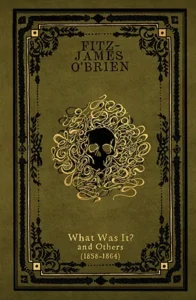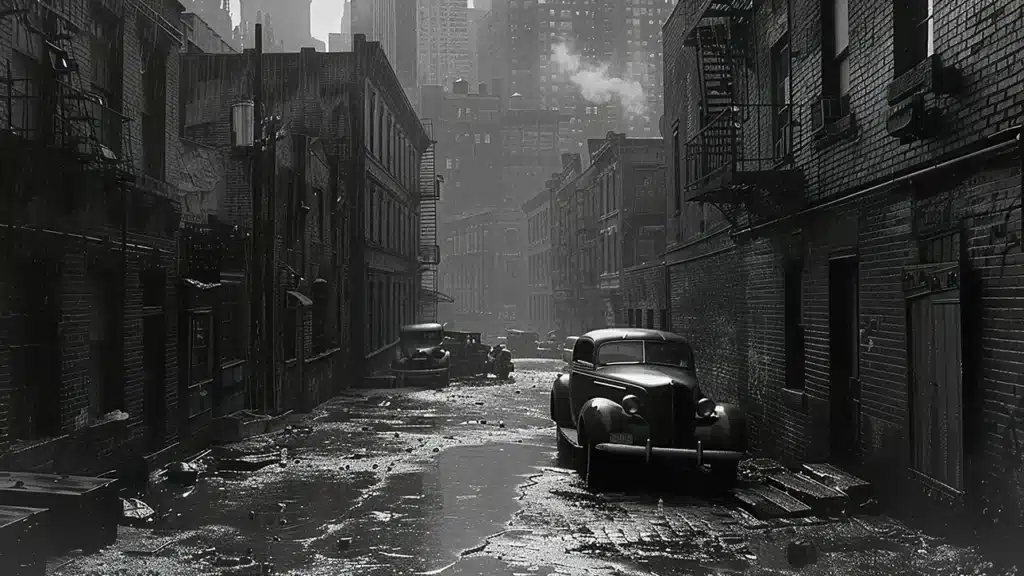
Fitz-James O’Brien’s exuberantly morbid stories, set amongst mid-century New York’s boarding houses and alleyways, are works of comic skepticism and cosmic messiness.
 What Was It Fitz-James O’Brien Swan River March 2025
What Was It Fitz-James O’Brien Swan River March 2025
In the March 1920 edition of The Catholic World, writer and journalist Fitz-James O’Brien was memorialised as “the Celtic Poe”, a phrase that combines a compliment with a category error. “Celtic” is a label for languages, mythologies, and revivals; it’s for peoples, not persons. Indeed, it is an aesthetic posture barely evident in the author’s work. The phrase is meant to imply more than the simple word, Irish, would.
O’Brien was Irish by birth, yes, but also American by temperament, habit, and nationality. He died in 1862 of wounds sustained while fighting for the Union, an end as thoroughly American as a Fourth of July firework mishap or Emily Dickinson’s apple pie.

By the time of his early death, Fitz-James O’Brien had already been naturalised, not just legally but imaginatively. He had ceased to be a visitor from Ireland and instead became a curious lodger in American letters. His stories, set among the boarding houses and alleyways of mid-century New York, have more in common with Nathaniel Hawthorne’s psychological gothics and Edgar Allan Poe’s grotesques than with any bardic fog of the Celtic Twilight. Poe, incidentally, had Ulster ancestry himself. His grandfather hailed from County Cavan, but he’s never called the American O’Brien.
H.P. Lovecraft, who never wrote for The Catholic World and probably never read it without gloves on, dubbed O’Brien “among the earliest of Poe’s disciples” in Supernatural Horror in Literature, citing the remarkable tales “What Was It?”, a pioneering story of an invisible assailant, and “The Diamond Lens”, a quietly deranged fable about a microscopist who falls in love with a woman discovered in a water droplet – as mad as anything in Poe’s cabinet of curiosities.
Lovecraft’s brief but shrewd take on O’Brien’s work concludes that “early death undoubtedly deprived us of some masterful tales of strangeness and terror.” It is one of the few enduring endorsements O’Brien has received, even as his most inventive work has been periodically rediscovered and anthologised across the decades.
Fitz-James O’Brien’s output in his short life was prodigious: just under 300 stories, many published anonymously in magazines and journals. Of these, just under half can be considered speculative, ranging from ghost stories and comic fantasy to early science fiction. Yet, he published no books in his lifetime. The first posthumous collection, 1881’s The Poems and Stories of Fitz-James O’Brien, edited by his friend William Winter, freely changed the text. It wasn’t until 1988 that the unaltered versions of his best stories were collected in The Supernatural Tales of Fitz-James O’Brien, edited by Jessica Amanda Salmonson. Even then, the two volumes were necessarily partial.
Fitz-James O’Brien’s Work Roams Between Borders
Now, with this new three-volume set from Swan River Press, The Collected Speculative Fiction of Fitz-James O’Brien, we finally have a complete accounting of O’Brien’s imaginative output, along with a perceptive series of biographical introductions by John P. Irish, who acts here not only as editor but as literary archaeologist, psychopomp, and advocate. It is the most comprehensive attempt yet to situate O’Brien firmly within the canon of 19th-century fantastical literature, an act of literary archaeology as much as curation, meticulously assembling obscure early works, placing them in their historical contexts, and tracing the evolution of O’Brien’s voice.
Fitz-James O’Brien’s oeuvre, once scattered, now coheres, not just as a body of work, but as a literary persona. And what a persona. He was a “man about town”, equally at home among Bohemian aesthetes and Bowery grotesques. His column under that name bridged journalism and fiction in the same spirit that his short stories bridged romanticism and something more modern: science fiction, urban gothic, surrealism before the word existed. He is, at times, a Victorian Jorge Luis Borges or, to bring him closer to home, an Edgar Allan Poe with a more ironic turn of phrase.
Volume One of this set contains Fitz-James O’Brien’s earliest and least known writings, mostly unearthed from Irish and English periodicals, a period dominated by poetry, philosophy, and literary fragments. O’Brien’s poetry of this time is scattershot but revealing: steeped in romantic nationalism, lyrical descriptions of the Irish landscape, and laced with early signs of the social conscience that would continue in his later work.
Irish disagrees with Fitz-James O’Brien’s only full biographer, Francis Wolle, who claimed the writer was embarrassed by his Irish origins, but the evidence suggests otherwise. O’Brien’s poetry is steeped in Irish pastoral imagery, and he returned to Irish subjects throughout his career, including in his most successful American play, A Gentleman from Ireland. A sentimental poem like “The Ballad of the Shamrock”, published in Harper’s in 1861, is less an act of assimilation than a declaration of dual identity.
Indeed, one could say that Fitz-James O’Brien’s fiction is immigrant fiction, not merely in terms of biography, but in theme. His best work doesn’t belong entirely to one nation or one genre, but roves between borders, like the invisible creature he imagined in “What Was It?”
A Man Understood in Fragments
The real transformation, however, occurs once Fitz-James O’Brien arrives in New York in 1852. He found both subject and style amid the Bohemian ferment of Pfaff’s beer cellar. He conceived of the fragmented “Fragments from an Unpublished Magazine”, a proto-metafictional experiment in which stories and poems are presented as entries from a mysterious book edited by the occultish Adam Eagle. It’s a brilliant, unfinished literary conceit, one of those postmodern tricks pulled off a century ahead of schedule.
It’s tempting to read this metafictional construction as a key to Fitz-James O’Brien himself: a man understood in fragments, seen dimly through the frames constructed by editors, strangely illuminated by the shadow Poe casts. In a sense, this new Swan River Press edition is the long-lost magazine from which these fragments were drawn, a work that gains its magical force by being incomplete. This may be a collected work, but it is haunted by phantom potential, stories unwritten, a trajectory outlined, but not followed.
By the time we reach “The Bohemian”, from 1855, in Volume Two, a mordant, stylish amalgam of Poe and Hawthorne that also pays tribute to the writer’s circle of downtown dropouts, it’s clear Fitz-James O’Brien had learned to weaponize his influences. His New York stories shift in focus to the urban Gothic. New York’s vibrant, multicultural streets become a backdrop for speculative tales that draw on a broader range of characters and ethnicities than most of his contemporaries. In this sense, O’Brien stands as an early chronicler of the American urban imagination: an immigrant writer capturing the rhythms and mysteries of a new city and finding in its foggy alleys the perfect setting for the weird and the uncanny.
He was also more playful than his contemporaries and recent predecessors. There’s something whimsical about his science fiction. “The Wondersmith”, in which dolls come to life to murder Christian children at Christmas, is a grotesque tale that nonetheless skips along with the dark glee of a penny dreadful, the junction by which we get from E.T.A. Hoffmann to a more recent story of Irish-American childermass, Tommy Lee Wallace’s 1982 supernatural horror, Halloween III: Season of the Witch.
“How I Overcame My Gravity”, a lesser-known story from the final years of his life, imagines an anti-gravitational formula with all the solemnity of a man designing the jetpack on a soggy beermat. One wonders if H.G. Wells ever stumbled on these tales; there are hints of influence, though nothing conclusive. Certainly, O’Brien anticipated a science-fictional mode that wouldn’t have a name until long after he was gone.
Comic Skepticism / Cosmic Messiness
The Poe comparisons, while valid in some respects, flatten more than they reveal. Yes, both writers shared an interest in the weird, the poetic, and the scientifically grotesque. Both struggled with alcohol, poverty, and professional instability. Both died young and were posthumously mythologised. However, while Poe’s aesthetic was deeply internal, psychological, and often claustrophobic, O’Brien’s was outward-looking, cosmopolitan, and playful. To place O’Brien in the American literary tradition (and this edition makes a compelling case that we must), he belongs somewhere between Mark Twain’s comic skepticism and Herman Melville’s cosmic messiness.
If anything, Fitz-James O’Brien anticipated writers like Ambrose Bierce and Jorge Luis Borges in his fusion of the fragmentary, the bibliophilic, and the macabre. There is a storyteller’s delight in O’Brien’s work, a kind of exuberant morbidity. Even when the stories fail (and not all of them succeed), the ambition and energy are undeniable. The fact that O’Brien might have gone on to become a central figure in American letters is not idle speculation.
What he lacked, as Lovecraft and Irish note, was time. Fitz-James O’Brien died in his mid-30s, a casualty of the American Civil War and, more profoundly, of a bohemian life lived at reckless speed. Like so many 19th-century geniuses, he burned brightly and briefly. Unlike those figures, he left behind a body of work that has remained, until now, elusive. With this edition, he is less a ghost and more a revenant: restored, reassembled, and recognised.
One of the few problems with publishing a complete works is that you can no longer use the excuse that “the best stuff was lost”. Swan River has left us with no such wiggle room. O’Brien’s speculative fiction, in full, is here. And it is, if not uniformly brilliant, at least uniformly interesting. At his best, he was the equal of any of his American contemporaries. At his worst, he was an innovator in search of the right ink.
The strange pleasure of reading Fitz-James O’Brien today lies in this contradiction. He is both major and minor, prophetic and derivative, Irish and American, real and invented. His literary presence is not unlike the mysterious Adam Eagle: haunting the pages of books he may or may not have written. The mythical book, printed at last. The invisible made visible.


